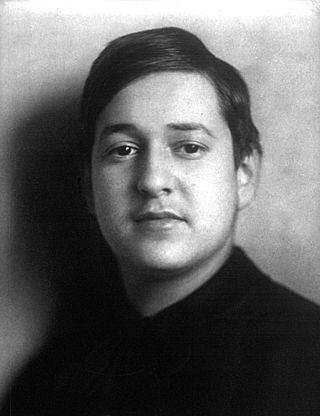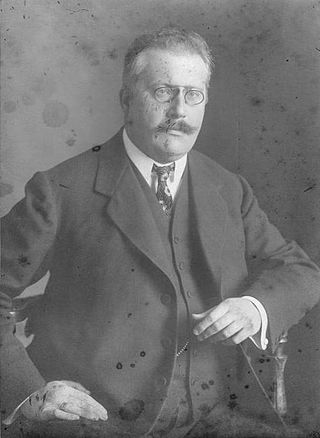Related Research Articles

The Symphony No. 3 in D minor by Gustav Mahler was written in sketch beginning in 1893, composed primarily in 1895, and took final form in 1896. Consisting of six movements, it is Mahler's longest composition and is the longest symphony in the standard repertoire, with a typical performance lasting around 95 to 110 minutes. It was voted one of the ten greatest symphonies of all time in a survey of conductors carried out by the BBC Music Magazine.

Erich Wolfgang Korngold was an Austrian composer and conductor, who fled Europe in the mid-1930s and later adopted US nationality. A child prodigy, he became one of the most important and influential composers in Hollywood history. He was a noted pianist and composer of classical music, along with music for Hollywood films, and the first composer of international stature to write Hollywood scores.

Julius Leopold Korngold was an Austrian music critic. He was the leading critic in early twentieth century Vienna, serving as chief music critic of the Neue Freie Presse from 1904 to 1934. His son was the composer Erich Wolfgang Korngold, whom he named after Wolfgang Amadeus Mozart, one of his favorite composers.
C minor is a minor scale based on C, consisting of the pitches C, D, E♭, F, G, A♭, and B♭. Its key signature consists of three flats. Its relative major is E♭ major and its parallel major is C major.
D major is a major scale based on D, consisting of the pitches D, E, F♯, G, A, B, and C♯. Its key signature has two sharps. The D major scale is:
F-sharp major is a major scale based on F♯, consisting of the pitches F♯, G♯, A♯, B, C♯, D♯, and E♯. Its key signature has six sharps.
G-flat major is a major scale based on G♭, consisting of the pitches G♭, A♭, B♭, C♭, D♭, E♭, and F. Its key signature has six flats.
C-sharp minor is a minor scale based on C♯, with the pitches C♯, D♯, E, F♯, G♯, A, and B. Its key signature consists of four sharps.
A-flat minor is a minor scale based on A♭, consisting of the pitches A♭, B♭, C♭, D♭, E♭, F♭, and G♭. Its key signature has seven flats. Its relative major is C-flat major, its parallel major is A-flat major, and its enharmonic equivalent is G-sharp minor.
Erich Wolfgang Korngold composed his Violin Concerto in D major, Op. 35, in 1945.

Alexander Frey, KM, KStJ, is an American symphony orchestra conductor, virtuoso organist, pianist, harpsichordist and composer. Frey is in great demand as one of the world's most versatile conductors, and enjoys success in the concert hall and opera house, and in the music of Broadway and Hollywood. Leonard Bernstein referred to him as "a wonderful spirit".
Progressive tonality is the music compositional practice whereby a piece of music does not finish in the key in which it began, but instead 'progresses' to an ending in a different key or tonality. In this connection 'different key' means a different tonic, rather than merely a change to a different mode : Gustav Mahler's Second Symphony (1888–94), for example, which moves from a C minor start to an E-flat major conclusion, exhibits 'progressive tonality'—whereas Ludwig van Beethoven's Fifth Symphony (1804–08), which begins in C minor and ends in C major, does not. A work which ends in the key in which it began may be described as exhibiting 'concentric tonality'. The terms 'progressive' and 'concentric' were both introduced into musicology by Dika Newlin in her book Bruckner, Mahler, Schoenberg (1947).
Robin Hood is a ballet created by choreographer and artistic director Paul Vasterling for the Nashville Ballet in 1998. The full-length ballet is in two acts and contains the music of Erich Wolfgang Korngold. Although Korngold wrote music to the 1938 movie The Adventures of Robin Hood, no music from the film is used in the ballet. Korngold’s early chamber music is used, as well as his Theme and Variations, Op. 42, and movements from both his Symphony in F-sharp major and Violin Concerto. The suite Much Ado About Nothing is used extensively in both acts and concludes the ballet.

Karl Ignaz Weigl was a Jewish Austrian composer and pianist, who later became a naturalized American citizen in 1943.
The Sinfonietta in B major, Op. 5, is the first large-scale orchestral work written by the 20th-century Austrian composer Erich Wolfgang Korngold. Korngold began sketching the work in the spring of 1912, just before his 15th birthday and finished the sketches in August 1912. The orchestration of it dragged on for another year, until September 1913, by which time Korngold had composed his Violin Sonata, Op. 6, and had begun his first opera Der Ring des Polykrates, Op. 7. The Sinfonietta was premiered in Vienna on 30 November 1913 under the direction of Felix Weingartner, and was a sensational success, resulting in further performances all over Europe and America.
Harold Byrns was a German-American conductor and orchestrator.

Julius Bittner was an Austrian composer.
Klaus Simon is a German classical pianist and conductor.
Yoel Gamzou is an Israeli-American conductor and composer, known for works by Gustav Mahler, especially his completion of Mahler's Symphony No. 10. He has been music director at the Theater Bremen from 2017, and has conducted at major European opera houses.
References
- ↑ Blaukopf, Kurt (1985). Gustav Mahler. Limelight Eds., ISBN 978-0-87910-029-2
- ↑ Carroll, Brendan G. (1997). The last prodigy: a biography of Erich Wolfgang Korngold. Amadeus Press, ISBN 978-1-57467-029-5